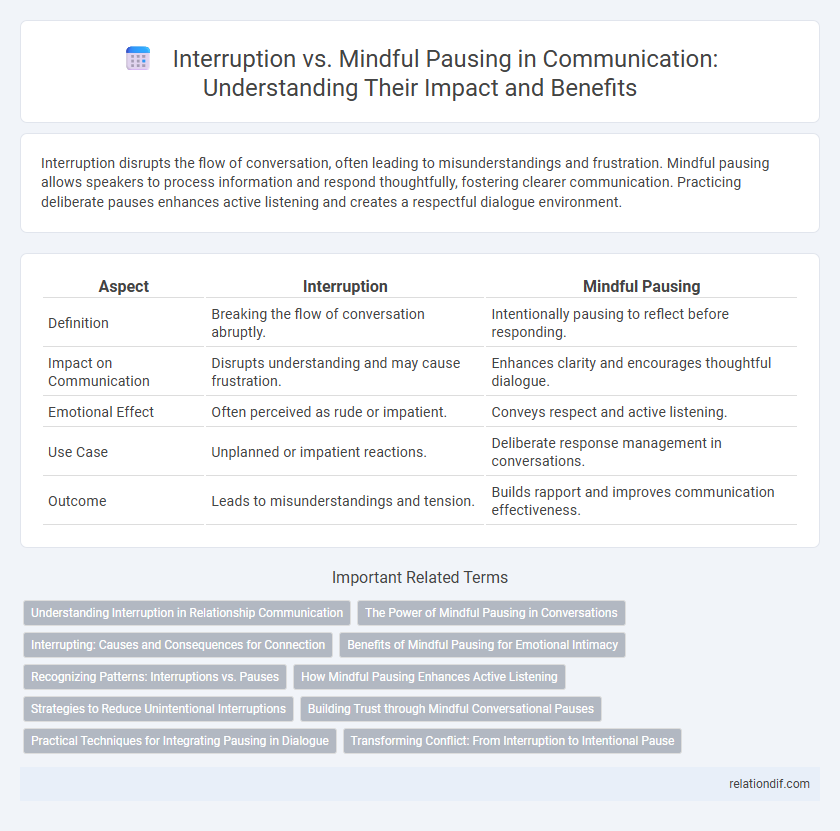Interruption disrupts the flow of conversation, often leading to misunderstandings and frustration. Mindful pausing allows speakers to process information and respond thoughtfully, fostering clearer communication. Practicing deliberate pauses enhances active listening and creates a respectful dialogue environment.
Table of Comparison
| Aspect | Interruption | Mindful Pausing |
|---|---|---|
| Definition | Breaking the flow of conversation abruptly. | Intentionally pausing to reflect before responding. |
| Impact on Communication | Disrupts understanding and may cause frustration. | Enhances clarity and encourages thoughtful dialogue. |
| Emotional Effect | Often perceived as rude or impatient. | Conveys respect and active listening. |
| Use Case | Unplanned or impatient reactions. | Deliberate response management in conversations. |
| Outcome | Leads to misunderstandings and tension. | Builds rapport and improves communication effectiveness. |
Understanding Interruption in Relationship Communication
Interruption in relationship communication often disrupts the flow of dialogue and can signal disregard for the speaker's thoughts, leading to misunderstandings and emotional disconnect. Mindful pausing, in contrast, fosters active listening by allowing space for reflection and ensuring that responses are thoughtful and respectful. Recognizing the difference enhances emotional intimacy and strengthens mutual understanding between partners.
The Power of Mindful Pausing in Conversations
Mindful pausing in conversations enhances communication by allowing individuals to process information deeply and respond thoughtfully, reducing misunderstandings and promoting clarity. This practice fosters active listening, where attention shifts from formulating a response to fully comprehending the speaker's message. Unlike interruptions that disrupt flow and convey impatience, mindful pauses create space for reflection, emotional regulation, and stronger interpersonal connections.
Interrupting: Causes and Consequences for Connection
Interrupting during communication often stems from impatience, eagerness to share, or a desire to control the conversation flow. This behavior disrupts the speaker's expression and diminishes trust, leading to weakened interpersonal connections. Persistent interruptions can cause frustration, reduce empathy, and hinder effective understanding between participants.
Benefits of Mindful Pausing for Emotional Intimacy
Mindful pausing in communication fosters deeper emotional intimacy by allowing individuals to fully process and respond to feelings, promoting understanding and empathy. This deliberate pause reduces reactive interruptions, creating a safe space for authentic connection and active listening. Neuroscientific studies show that mindful pausing activates brain regions linked to emotional regulation, enhancing relational trust and emotional clarity.
Recognizing Patterns: Interruptions vs. Pauses
Recognizing patterns in communication involves distinguishing between interruptions, which disrupt the speaker's flow and signal impatience or dominance, and mindful pauses that create space for reflection and active listening. Skilled communicators observe speech rhythms, noting when a pause invites thoughtful response rather than breaks engagement. This awareness enhances conversational dynamics, fostering respect and deeper understanding.
How Mindful Pausing Enhances Active Listening
Mindful pausing in communication allows individuals to process information fully, leading to deeper understanding and more thoughtful responses. Unlike interruptions, which disrupt the speaker's flow and intent, pausing demonstrates respect and attentiveness, enhancing active listening skills. This deliberate silence creates space for empathy, reducing misunderstandings and fostering more meaningful interactions.
Strategies to Reduce Unintentional Interruptions
Mindful pausing enhances communication by allowing speakers to complete their thoughts without disruption, fostering clearer understanding. Strategies to reduce unintentional interruptions include active listening techniques, such as maintaining eye contact and acknowledging points before responding. Implementing structured turn-taking and using non-verbal cues can also minimize interruptions and promote respectful dialogue.
Building Trust through Mindful Conversational Pauses
Mindful conversational pauses enhance communication by allowing individuals to process information deeply and respond thoughtfully, which fosters trust and openness. Interruptions often disrupt the flow of dialogue and can lead to misunderstandings, reducing relational safety. Consistent use of intentional pauses signals respect and attentiveness, reinforcing trust and strengthening collaborative relationships.
Practical Techniques for Integrating Pausing in Dialogue
Mindful pausing in communication enhances clarity by allowing speakers to collect thoughts and listeners to process information, reducing the likelihood of disruptive interruptions. Techniques such as intentional breath pauses, silent counts, and reflective listening cues promote balanced dialogue and foster mutual understanding. Consistently integrating these methods into conversations improves overall communication effectiveness and emotional intelligence.
Transforming Conflict: From Interruption to Intentional Pause
Transforming conflict through communication requires shifting from impulsive interruption to intentional, mindful pausing, which fosters active listening and deeper understanding. Mindful pausing creates space for reflection, reducing emotional escalation and promoting constructive dialogue. This approach enhances empathy and collaboration, turning potential conflicts into opportunities for growth and resolution.
Interruption vs mindful pausing Infographic

 relationdif.com
relationdif.com